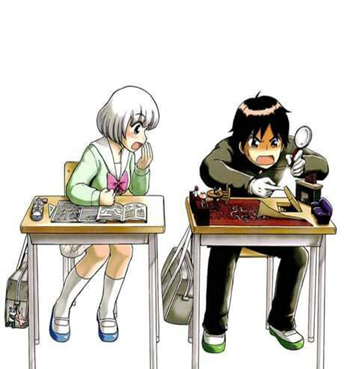
Takuma Morishige’s simple and endlessly inventive gem of a series is a nostalgic journey to the days of my childhood, when a lot of fun came from the recesses of a fevered mind.
For the uninitiated: Tonari no Seki-kun is about one thing, and one thing only: the various improvised games and contraptions by high-schooler Seki, and how they continue to distract his straight arrow classmate Rumi. Like many fans of this manga, I used to be a Seki myself. I wasn’t exactly good with my hands, but I do have ample ability to improvise with everyday objects. Pieces of paper, twigs, pebbles, coins, tiles, bottlecaps… my favorite prop might be my chess set, which I used for other things way more often than for its intended purpose. You could invent and/or simulate so many games just by using chess pieces and a coin! And then, there were the simulacrums. Seki has a robot family? Meh, I kept a dinosaur neighborhood in my drawer, back when Jurassic Park caused every single kid in the 1990s to fall in love with the big fellas.
Those tend to stay at home, as I mostly played regular pre-established games in grade school. I didn’t met many ‘Seki kids’ either, apart from a few instances like when Pokemon fans got together to play the game with a pen-and-paper mechanic. I did fantasize a lot: the school backyard was a treacherous mountain with mysterious creatures, the hallways are full of imaginary shops…. that sort of stuff. I didn’t share that world with any schoolmate as far as I can recall, but in retrospect I really should have.
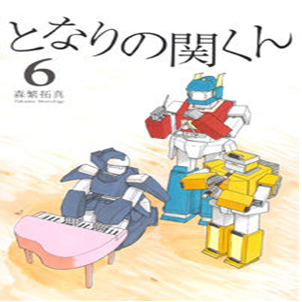
Indeed,prop alone isn’t enough. You also need a boatload of imagination and the conviction to role-play in order to bring all your neat ideas to life. Seki-kun understands and nails that kind of sensation through the moment in nearly every story when Rumi figures out (and embellishes) the narrative in Seki’s game. Just like how it is in real life when you see people really taking these kind of scenario to heart, it’s also fun to see Rumi and Seki do the same, whether it’s rugby match with finger puppets, soap opera with shougi pieces, or surgery operation on broken plush dolls.
The make believe extends to supporting character Goto, who believes that Rumi and Seki are a couple and willfully misinterpret every single instance of their interaction to fit her narrative. In a way, it’s just another game. A game of projection, not unlike the one where you see strangers in public places and construct narrative about them in your head, also meant to inject some romance and adventure into the mundane repetition of daily lives.
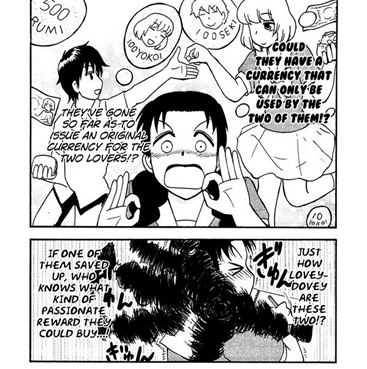
Much like a vast majority of manga and anime, Tonari no Seki-kun is set in high school, when most kids who used to be Seki have grown out of it and busy themselves with schoolwork and/or relationship. Likewise, I’ve left all my childish props and fantasy behind in this period. Seki still carries on though, and while the manga probably shouldn’t be taken too seriously as a social commentary ( “I feel guilty that they really take such a meaningless comic to heart”, Morishige joked about his grade-schooler fans in one of his author’s notes), Seki inevitably feels like a refreshing anti-thesis to the rigid nature of educational establishment and the nation of Japan as a whole. He’s ‘the nail that refused to be hammered down’, conveying free-form ingenuity and tendency to establish new rules in place of the pre-established ones through his games.
Further underlining the character’s abstract nature, Morishige makes an interesting stylistic choice by portraying Seki as a silent character, whose lines of dialogue aren’t ever shown despite his huge role. It may sounds like an unnecessary and counter-productive restriction, but it works beautifully here, lending a touch of endearing surrealism to the interaction between Seki and Rumi and amping up the former’s zaniness. It’s also fun to see an artist conveying a character’s personality through facial expression and body language alone!
(Rensuke Oshikiri’s High Score Girl deploys similar technique to its main female character; the manga reads like a gender-swapped version of Seki-kun at times, only with video games and more of an overarching plot. Similar sense of shameless nostalgia, though).
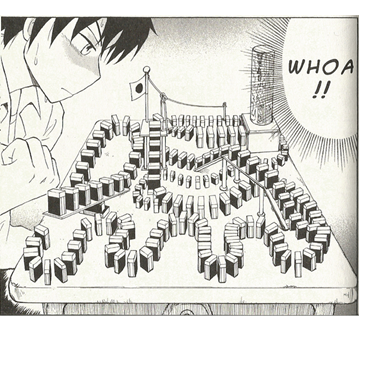 So yeah, Seki is a concept, a piece of childhood that we wish we could regain. But, Rumi is just as important—the spectator, the opponent, the Player 2, the co-scriptwriter. Even as Seki does his thing mostly for his own entertainment, there are times when he actively involve Rumi in them, fishing for reaction, and generally have a grand old time impressing (and frustrating) the hell out of her. Rumi providing a running commentary/reaction takes and butting in Seki’s games, voluntarily or not, is what makes the manga really ticks.
So yeah, Seki is a concept, a piece of childhood that we wish we could regain. But, Rumi is just as important—the spectator, the opponent, the Player 2, the co-scriptwriter. Even as Seki does his thing mostly for his own entertainment, there are times when he actively involve Rumi in them, fishing for reaction, and generally have a grand old time impressing (and frustrating) the hell out of her. Rumi providing a running commentary/reaction takes and butting in Seki’s games, voluntarily or not, is what makes the manga really ticks.
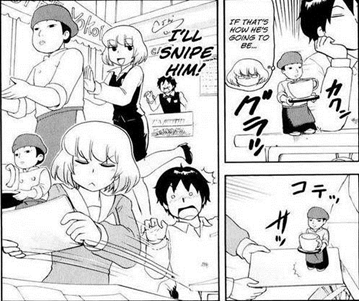
My own ‘Rumi’ was a neighbor kid who used to play a lot with me back then. When I came to house, it’s mostly NES (later PlayStation) time; when he came over, I had to bust out my improv game as I didn’t own a video game console at the time. Once, we used an atlas for a make believe world race game, marking each tile in my house as an individual country. There are similar chapters in Seki-kun that makes me smile fondly and remember that good old time, particularly when Seki and Rumi are strong-arming each other to play in their respective preferred way.
As much fun as you can have by yourself, every Seki eventually needs a Rumi. A dynamic foil to bounce ideas off. Someone whose eyes lit up whenever they see you doing your usual silly stuff. Someone worth showing off for.
Robot Family is the best!
I was a Rumi myself. But I like how you never know who is going to “win”. It’s nice how Rumi doesn’t always suffer. Sometimes she’s the victim, sometimes the willing participant, and sometimes the victor. It helps keep the manga interesting.
LikeLike
Yeah, that’s an excellent point. I think at the beginning she definitely felt more like a victim, but I really enjoy it when she takes the role of ‘justice’ and trying to save the imaginary characters from Seki’s ‘tyranny’; that’s like her favorite narrative, haha.
LikeLiked by 1 person
As a livelong lover of LEGO, action figures, Gunpla, and other such imagination kickstarters, Seki always fascinated me and resonated with me as I read through the manga. As I’m going into college, I’m leaning a bit more towards Rumi, but I definitely have a wiiiide streak of Seki in me. They both seem to mirror two aspects of growing up when you hit a certain age in your teenage years: the side that wants to be mature and turn into a proper adult, and the child-like side that still wants to see the wonder in the world. It’s a really fun manga to read that has a certain charm to it. Thanks for sharing your thoughts. 🙂
LikeLiked by 1 person
Thank you for the great insight and for sharing your story!
And yeah, this manga sure made me think a lot about my past days as Seki. A lot of them felt very silly in retrospect, but I do miss that side of myself and all those make-believe games, haha.
LikeLike